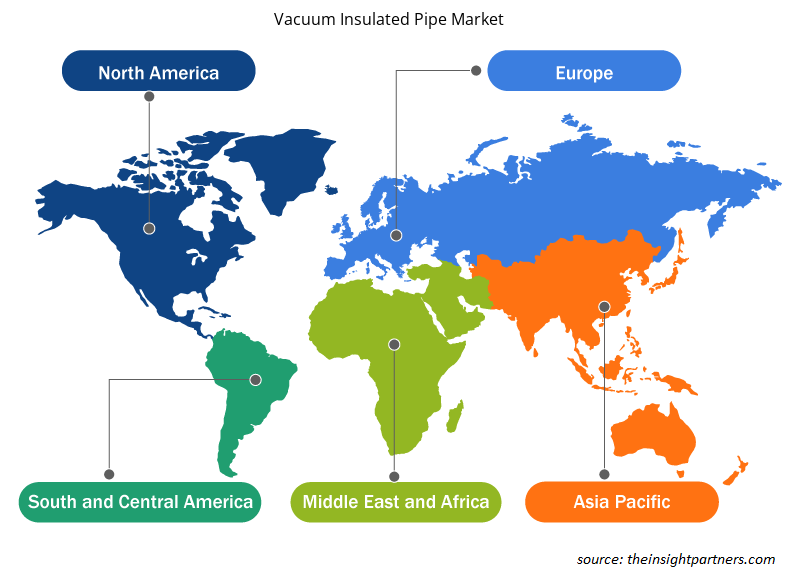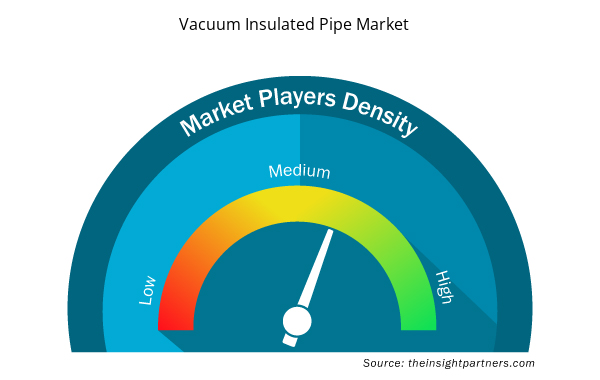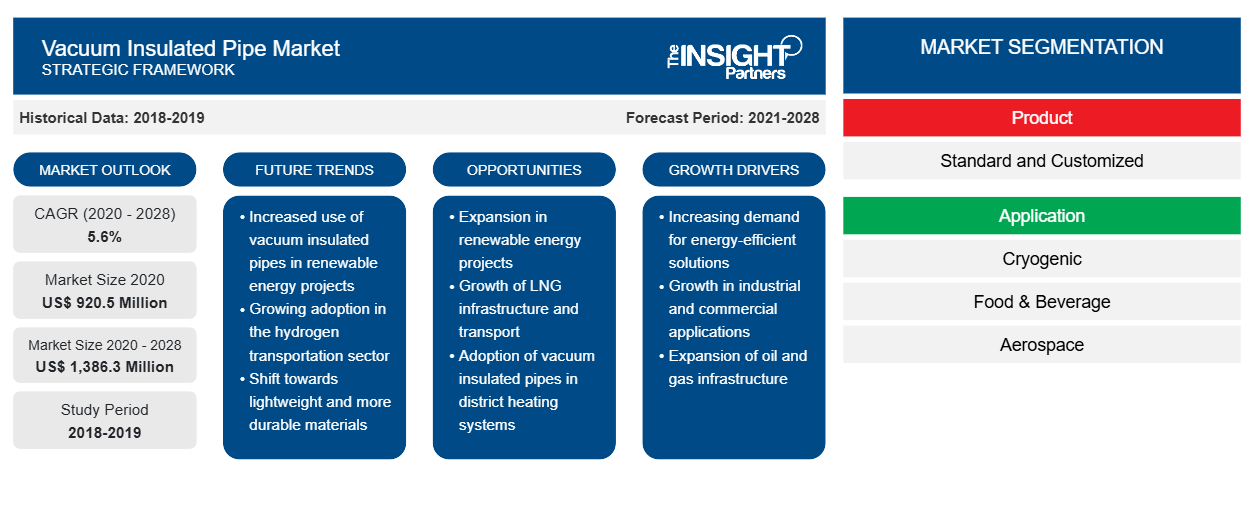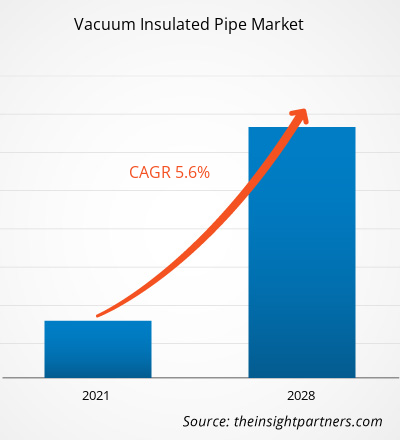Il mercato dei tubi isolati sotto vuoto è stato valutato a 920,5 milioni di dollari nel 2020 e si prevede che raggiungerà 1.386,3 milioni di dollari entro il 2028; si prevede una crescita a un CAGR del 5,6% nel periodo 2021-2028.
Si prevede che il mercato dei tubi isolati sotto vuoto registrerà una crescita considerevole durante il periodo di previsione. L'uso di tubi isolati sotto vuoto nell'applicazione GNL sta crescendo grazie ai suoi vantaggi, come la riduzione della riliquefazione, minori perdite di liquido e un flusso di GNL più elevato su distanze maggiori, che sta guidando la crescita del mercato dei tubi isolati sotto vuoto. Inoltre, la crescente domanda di tubi isolati sotto vuoto tra gli utenti finali, dovuta alle sue proprietà di isolamento superiori, alla durata e alle operazioni senza manutenzione, sta ulteriormente accelerando la crescita del mercato.
Il mercato dei tubi isolati sottovuoto è segmentato in base al prodotto e all'applicazione. In base al prodotto, si prevede che il segmento personalizzato registrerà una crescita CAGR più elevata durante il periodo di previsione. La crescita del mercato per questo segmento è attribuita alla crescente domanda di tubi isolati sottovuoto personalizzati nei settori del petrolio e del gas, dell'energia e dell'assistenza sanitaria a causa dei sistemi di specifica del settore. In base all'applicazione, si prevede che il segmento alimentare e delle bevande manterrà la quota di mercato dominante. L'aumento del reddito pro capite dei consumatori insieme allo sviluppo del settore degli imballaggi alimentari sono i fattori chiave che spingono la crescita del settore alimentare e delle bevande. Inoltre, il crescente commercio di alimenti confezionati e prodotti surgelati ha fornito opportunità commerciali redditizie al mercato per il segmento personalizzato.
Personalizza questo report in base alle tue esigenze
Riceverai la personalizzazione gratuita di qualsiasi report, comprese parti di questo report, o analisi a livello nazionale, pacchetto dati Excel, oltre a usufruire di grandi offerte e sconti per start-up e università
- Scopri le principali tendenze di mercato in questo rapporto.Questo campione GRATUITO includerà analisi di dati che spaziano dalle tendenze di mercato alle stime e alle previsioni.
Impatto della pandemia di COVID-19 sul mercato dei tubi isolati sottovuoto
Secondo l'ultimo rapporto dell'Organizzazione Mondiale della Sanità (OMS), Stati Uniti, Spagna, Italia, Francia, Germania, Regno Unito, Russia, Turchia, Brasile, Iran e Cina sono tra i paesi più colpiti dall'epidemia di COVID-19. La crisi del COVID-19 sta colpendo le industrie in tutto il mondo e l'economia globale ha assistito al peggior colpo nel 2020 ed è probabile che continui anche nel 2021. L'epidemia ha creato notevoli interruzioni nei settori primari come cibo e bevande, medicina, energia ed energia, elettronica e semiconduttori, petrolio e prodotti chimici. Le chiusure delle fabbriche, i divieti di viaggio, i divieti commerciali e i blocchi delle frontiere per combattere e contenere l'epidemia hanno avuto un impatto sulla produzione, la fornitura e la vendita di attrezzature industriali necessarie per la produzione di tubi isolati sotto vuoto. Un calo significativo delle attività nelle industrie sta ostacolando la crescita del mercato globale dei tubi isolati sotto vuoto.lockdowns to combat and contain the outbreak have impacted manufacturing, supply, and sales of industrial equipment that are required for the manufacturing of vacuum insulated pipe. A significant decline in the activities in industries is hindering the growth of the global vacuum insulated pipe market.
Approfondimenti sul mercato dei tubi isolati sotto vuoto
Politiche di supporto al carburante pulito
Diverse autorità governative in tutto il mondo stanno supportando e imponendo le politiche sui carburanti puliti, che vengono implementate nelle rispettive regioni. Ad esempio, a marzo 2021, il Senato dello stato del New Mexico ha approvato un disegno di legge per introdurre uno standard sui carburanti puliti, che probabilmente li aiuterà a raggiungere i loro obiettivi di riduzione del carbonio. Tali iniziative si concentrano sulla limitazione dell'uso di carburanti convenzionali nei trasporti. Di conseguenza, si prevede che il gas naturale emergerà rapidamente come combustibile alternativo e sarebbe il secondo maggiore contributore al mix energetico, rappresentando il 25% entro il 2045.
Nella regione Asia-Pacifico, molti governi stanno incentivando i consumatori a convertire i loro veicoli in veicoli alimentati a gas pulito (GPL). Il governo indiano sta pianificando di tagliare la GST (imposta sui beni e servizi) sui kit di conversione insieme a fornire un supporto sussidiario ai consumatori che passano a carburanti rispettosi dell'ambiente. Inoltre, la crescita del mercato dei tubi isolati sotto vuoto nella regione sarebbe supportata dalla crescente domanda di gas naturale liquefatto (GNL) con i settori aerospaziale e manifatturiero in rapida crescita. Pertanto, le crescenti iniziative governative volte ad adottare politiche sui combustibili puliti stanno rafforzando la domanda di GNL, favorendo di conseguenza l'adozione di tubi isolati sotto vuoto negli impianti di petrolio e gas.
Approfondimenti di mercato basati sui prodotti
In base al prodotto, il mercato dei tubi isolati sotto vuoto è diviso in standard e personalizzati. Il segmento standard ha guidato il mercato nel 2020. I tubi standard sono considerati tubi isolati convenzionali e detengono la quota di mercato maggioritaria. Questi tubi sono realizzati in acciaio e fusi con un vuoto tra i tubi interni ed esterni. I tubi isolati sotto vuoto sono disponibili in varie dimensioni che vanno da 0,5 pollici a più di 5 pollici. Inoltre, l'uso diversificato nel trasferimento di grandi volumi di liquidi criogenici tra cui GNL, idrogeno, azoto e altri sta guidando l'adozione di tubi isolati sotto vuoto standard. Inoltre, il crescente numero di PMI nelle economie emergenti nell'area APAC, unito alla facilità di trasporto e al costo inferiore dei tubi standard rispetto ai tubi isolati sotto vuoto standard personalizzati, sono tra gli altri fattori che spingono la crescita del mercato per il segmento dei tubi isolati sotto vuoto standard.
Gli operatori che operano nel mercato dei tubi isolati sotto vuoto si concentrano su strategie quali fusioni, acquisizioni e iniziative di mercato per mantenere le proprie posizioni sul mercato. Di seguito sono elencati alcuni sviluppi da parte degli operatori chiave:
Nel 2019, Air Liquide aumenta la sua quota in Air Liquide Munay Tech Gases (ALMTG) del 75%. La joint venture ha anche annunciato che sta pianificando di investire fino a 86 milioni di euro per acquisire unità di produzione di idrogeno e azoto dalla raffineria di Atyrau di proprietà di KazMunayGas. In base al nuovo accordo, LMTG gestirà queste attività per fornire gas industriali alla raffineria di Atyrau.
Nel 2021, Acme Cryogenics, Inc. ha acquisito Cryogenic Experts, Inc. L'acquisizione mirava ad ampliare la linea di prodotti di fluidi speciali criogenici e non criogenici dell'azienda e ad aumentare la sua presenza commerciale sulla costa occidentale degli Stati Uniti.
Approfondimenti regionali sul mercato dei tubi isolati sotto vuoto
Le tendenze regionali e i fattori che influenzano il mercato dei tubi isolati sotto vuoto durante il periodo di previsione sono stati ampiamente spiegati dagli analisti di Insight Partners. Questa sezione discute anche i segmenti e la geografia del mercato dei tubi isolati sotto vuoto in Nord America, Europa, Asia Pacifico, Medio Oriente e Africa e America meridionale e centrale.

- Ottieni i dati specifici regionali per il mercato dei tubi isolati sotto vuoto
Ambito del rapporto di mercato sui tubi isolati sotto vuoto
| Attributo del report | Dettagli |
|---|---|
| Dimensioni del mercato nel 2020 | 920,5 milioni di dollari USA |
| Dimensioni del mercato entro il 2028 | 1.386,3 milioni di dollari USA |
| CAGR globale (2020 - 2028) | 5,6% |
| Dati storici | 2018-2019 |
| Periodo di previsione | 2021-2028 |
| Segmenti coperti | Per Prodotto
|
| Regioni e Paesi coperti | America del Nord
|
| Leader di mercato e profili aziendali chiave |
|
Attori del mercato dei tubi isolati sotto vuoto Densità: comprendere il suo impatto sulle dinamiche aziendali
Il mercato dei tubi isolati sotto vuoto sta crescendo rapidamente, spinto dalla crescente domanda degli utenti finali dovuta a fattori quali l'evoluzione delle preferenze dei consumatori, i progressi tecnologici e una maggiore consapevolezza dei vantaggi del prodotto. Con l'aumento della domanda, le aziende stanno ampliando le loro offerte, innovando per soddisfare le esigenze dei consumatori e capitalizzando sulle tendenze emergenti, il che alimenta ulteriormente la crescita del mercato.
La densità degli operatori di mercato si riferisce alla distribuzione di aziende o società che operano in un particolare mercato o settore. Indica quanti concorrenti (operatori di mercato) sono presenti in un dato spazio di mercato in relazione alle sue dimensioni o al valore di mercato totale.
Le principali aziende che operano nel mercato dei tubi isolati sottovuoto sono:
- CRIOGENESI ACME
- LIQUIDO D'ARIA
- Grafico Industries, Inc.
- GRUPPO CRYENG PTY LTD.
- PRODUTTORI DI PRODOTTI PER LA PRODUZIONE ...
Disclaimer : le aziende elencate sopra non sono classificate secondo un ordine particolare.

- Ottieni una panoramica dei principali attori del mercato dei tubi isolati sottovuoto
Il mercato dei tubi isolati sotto vuoto è stato segmentato come segue:
Mercato dei tubi isolati sottovuoto – per prodotto
- Standard
- Personalizzato
Mercato dei tubi isolati sotto vuoto – per applicazione
- Criogenico
- Cibo e bevande
- Aerospaziale
- Produzione e collaudo elettronico
- Altri
Mercato dei tubi isolati sottovuoto – Per area geografica
America del Nord
- NOI
- Canada
- Messico
Europa
- Francia
- Germania
- Italia
- Regno Unito
- Russia
- Resto d'Europa
Asia Pacifico
- Cina
- India
- Corea del Sud
- Giappone
- Australia
- Resto dell'APAC
Medio Oriente e Africa
- Sudafrica
- Arabia Saudita
- Emirati Arabi Uniti
- Resto del MEA
Sud America
- Brasile
- Argentina
- Resto del SAM
Profili aziendali
- Marchio registrato
- Aria Liquida
- Società a responsabilità limitata
- Flexonica Senior
- Criogenia Acme
- Società a responsabilità limitata
- Criofabbrica
- Azienda
- Demaco
- Criogenia Sps BV
- Analisi storica (2 anni), anno base, previsione (7 anni) con CAGR
- Analisi PEST e SWOT
- Valore/volume delle dimensioni del mercato - Globale, regionale, nazionale
- Industria e panorama competitivo
- Set di dati Excel



Report Coverage
Revenue forecast, Company Analysis, Industry landscape, Growth factors, and Trends

Segment Covered
This text is related
to segments covered.

Regional Scope
North America, Europe, Asia Pacific, Middle East & Africa, South & Central America

Country Scope
This text is related
to country scope.
Domande frequenti
The vacuum insulated pipe market is led by customized segment with highest share and is expected to dominate in the forecast period. The rise in demand can be attributed to the rising demand of customized vacuum insulated pipe in oil & gas, energy, and healthcare sectors due to the industry’s specification systems.
Rise in partnerships and acquisitions is expected to create significant opportunity of the vacuum insulated pipe market growth. The demand for vacuum insulated pipe is escalating at a substantial pace across industries. Large organizations are strongly emphasizing on the adoption of such technologies to transport and store cryogenic liquids efficiently. In order to facilitate the buyers, the market players are either collaborating with well-established and industry-recognized vacuum insulated pipe manufacturer or conducting acquisition activities. The partnerships and acquisition activities are enabling the companies to adopt better technology for transferring the cryogenic liquid safely with more cost effective approach.
The growth of the vacuum insulated pipe market is primarily attributed to the rise in investments towards food & beverage, aerospace and semiconductor industry. Moreover, the oil and gas industry players are increasingly capitalizing on cryogenic liquids, thereby substantially driving the vacuum insulated pipe market.
Trends and growth analysis reports related to Manufacturing and Construction : READ MORE..
The List of Companies - Vacuum Insulated Pipe Market
- ACME CRYOGENICS
- AIR LIQUIDE
- Chart Industires, Inc.
- CRYENG GROUP PTY LTD.
- CRYOFAB, INC.
- CRYOWORKS, INC.
- DEMACO
- Senior Flexonics
- SPS CRYOGENICS B.V.
- TMK
The Insight Partners performs research in 4 major stages: Data Collection & Secondary Research, Primary Research, Data Analysis and Data Triangulation & Final Review.
- Data Collection and Secondary Research:
As a market research and consulting firm operating from a decade, we have published and advised several client across the globe. First step for any study will start with an assessment of currently available data and insights from existing reports. Further, historical and current market information is collected from Investor Presentations, Annual Reports, SEC Filings, etc., and other information related to company’s performance and market positioning are gathered from Paid Databases (Factiva, Hoovers, and Reuters) and various other publications available in public domain.
Several associations trade associates, technical forums, institutes, societies and organization are accessed to gain technical as well as market related insights through their publications such as research papers, blogs and press releases related to the studies are referred to get cues about the market. Further, white papers, journals, magazines, and other news articles published in last 3 years are scrutinized and analyzed to understand the current market trends.
- Primary Research:
The primarily interview analysis comprise of data obtained from industry participants interview and answers to survey questions gathered by in-house primary team.
For primary research, interviews are conducted with industry experts/CEOs/Marketing Managers/VPs/Subject Matter Experts from both demand and supply side to get a 360-degree view of the market. The primary team conducts several interviews based on the complexity of the markets to understand the various market trends and dynamics which makes research more credible and precise.
A typical research interview fulfils the following functions:
- Provides first-hand information on the market size, market trends, growth trends, competitive landscape, and outlook
- Validates and strengthens in-house secondary research findings
- Develops the analysis team’s expertise and market understanding
Primary research involves email interactions and telephone interviews for each market, category, segment, and sub-segment across geographies. The participants who typically take part in such a process include, but are not limited to:
- Industry participants: VPs, business development managers, market intelligence managers and national sales managers
- Outside experts: Valuation experts, research analysts and key opinion leaders specializing in the electronics and semiconductor industry.
Below is the breakup of our primary respondents by company, designation, and region:

Once we receive the confirmation from primary research sources or primary respondents, we finalize the base year market estimation and forecast the data as per the macroeconomic and microeconomic factors assessed during data collection.
- Data Analysis:
Once data is validated through both secondary as well as primary respondents, we finalize the market estimations by hypothesis formulation and factor analysis at regional and country level.
- Macro-Economic Factor Analysis:
We analyse macroeconomic indicators such the gross domestic product (GDP), increase in the demand for goods and services across industries, technological advancement, regional economic growth, governmental policies, the influence of COVID-19, PEST analysis, and other aspects. This analysis aids in setting benchmarks for various nations/regions and approximating market splits. Additionally, the general trend of the aforementioned components aid in determining the market's development possibilities.
- Country Level Data:
Various factors that are especially aligned to the country are taken into account to determine the market size for a certain area and country, including the presence of vendors, such as headquarters and offices, the country's GDP, demand patterns, and industry growth. To comprehend the market dynamics for the nation, a number of growth variables, inhibitors, application areas, and current market trends are researched. The aforementioned elements aid in determining the country's overall market's growth potential.
- Company Profile:
The “Table of Contents” is formulated by listing and analyzing more than 25 - 30 companies operating in the market ecosystem across geographies. However, we profile only 10 companies as a standard practice in our syndicate reports. These 10 companies comprise leading, emerging, and regional players. Nonetheless, our analysis is not restricted to the 10 listed companies, we also analyze other companies present in the market to develop a holistic view and understand the prevailing trends. The “Company Profiles” section in the report covers key facts, business description, products & services, financial information, SWOT analysis, and key developments. The financial information presented is extracted from the annual reports and official documents of the publicly listed companies. Upon collecting the information for the sections of respective companies, we verify them via various primary sources and then compile the data in respective company profiles. The company level information helps us in deriving the base number as well as in forecasting the market size.
- Developing Base Number:
Aggregation of sales statistics (2020-2022) and macro-economic factor, and other secondary and primary research insights are utilized to arrive at base number and related market shares for 2022. The data gaps are identified in this step and relevant market data is analyzed, collected from paid primary interviews or databases. On finalizing the base year market size, forecasts are developed on the basis of macro-economic, industry and market growth factors and company level analysis.
- Data Triangulation and Final Review:
The market findings and base year market size calculations are validated from supply as well as demand side. Demand side validations are based on macro-economic factor analysis and benchmarks for respective regions and countries. In case of supply side validations, revenues of major companies are estimated (in case not available) based on industry benchmark, approximate number of employees, product portfolio, and primary interviews revenues are gathered. Further revenue from target product/service segment is assessed to avoid overshooting of market statistics. In case of heavy deviations between supply and demand side values, all thes steps are repeated to achieve synchronization.
We follow an iterative model, wherein we share our research findings with Subject Matter Experts (SME’s) and Key Opinion Leaders (KOLs) until consensus view of the market is not formulated – this model negates any drastic deviation in the opinions of experts. Only validated and universally acceptable research findings are quoted in our reports.
We have important check points that we use to validate our research findings – which we call – data triangulation, where we validate the information, we generate from secondary sources with primary interviews and then we re-validate with our internal data bases and Subject matter experts. This comprehensive model enables us to deliver high quality, reliable data in shortest possible time.


 Ottieni un campione gratuito per questo repot
Ottieni un campione gratuito per questo repot